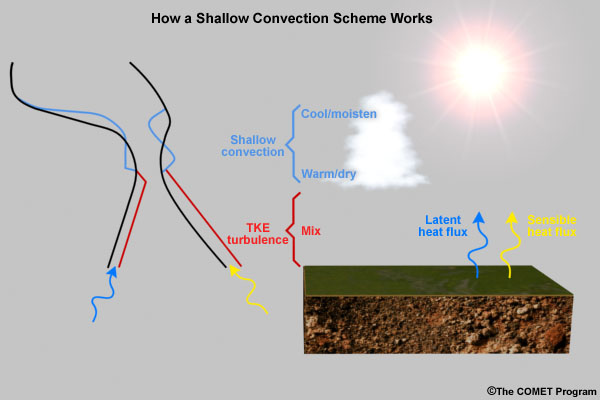Media elements used in this module are protected by a variety of copyright licenses. Please use the "copyright terms" link associated with each item below for more information.
Description:
This is a cartoon of how shallow convection schemes work. On the right are the physical processes involved: sensible and latent heat fluxes from the earth's surface serve to create and then heat and moisten the planetary boundary layer (PBL) through mechanical turbulence driven by vertical wind shear and buoyant eddies driven by horizontal differences in temperature and moisture. Numerical Weather Prediction (NWP) models either assume a vertical profile of mixing or directly calculate Turbulent Kinetic Energy (TKE) to determine the depth of the PBL. At the top of the PBL, either the PBL scheme is extended into the layers above the PBL to vent heat and moisture into the free atmosphere, or a separate shallow convection parameterization is employed. The shallow convection scheme emulates the effect of non-precipitating cumulus clouds by moistening and cooling layers near the tops of these non-precipitating model cumulus clouds, and warming and drying the layers near the bases of these clouds.
The left side illustrates the effects on the temperature and moisture in the PBL and the adjacent layers above it. Initial temperature and dewpoint profiles are in black. During the day, sensible and latent heat from the surface increase the temperature and dewpoint of the PBL, shifting both profiles to the right. At the top of the PBL, shallow convection acts to warm and dry the adjacent layers to the PBL top, shifting the temperature profile further right and the dewpoint profile to the left, essentially capping the PBL. Meanwhile, near the top of the model-determined shallow cumulus clouds, air is cooling and moistening, shifting the temperature curve left and the dewpoint curve right. This creates another inversion at the top of the shallow cumulus layer.
File Name:
shallowconv.jpg
Credits:
©The COMET Program
Copyright Terms:
COMET Standard Terms
of Use
